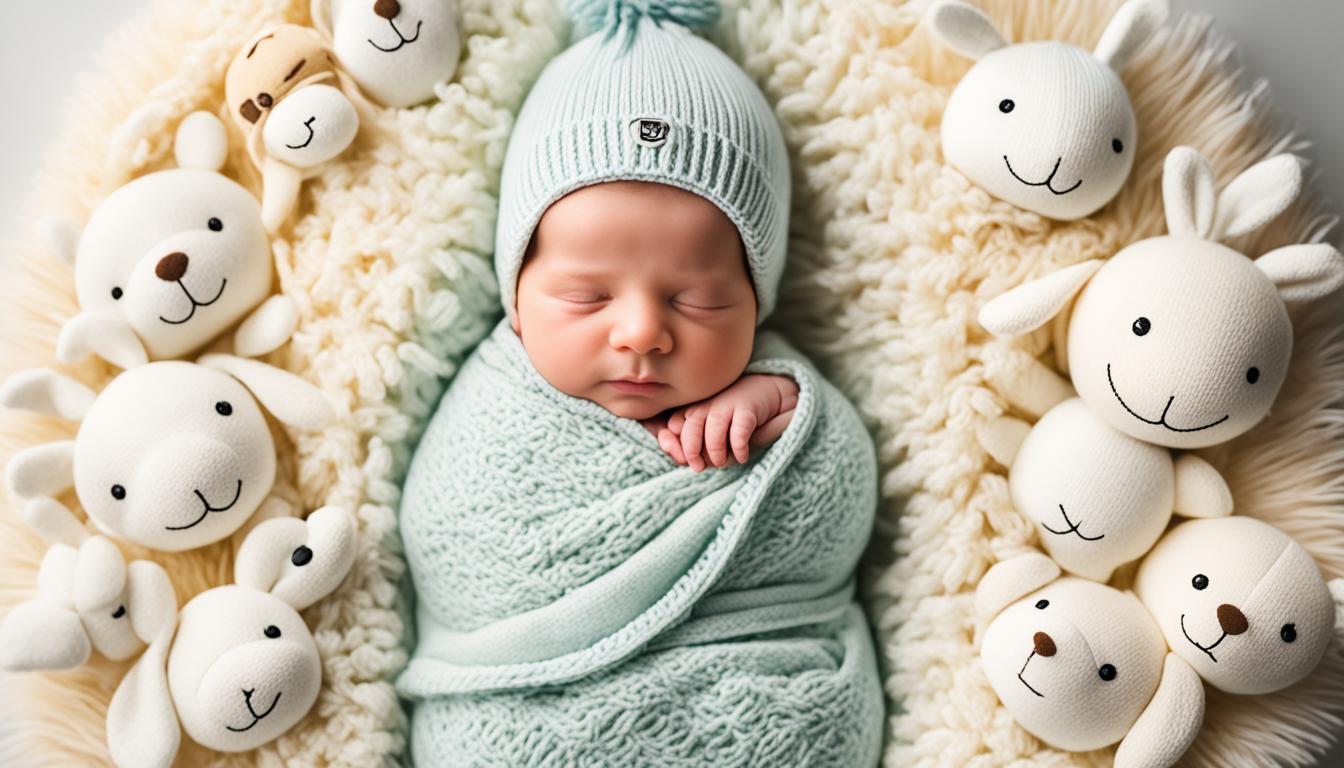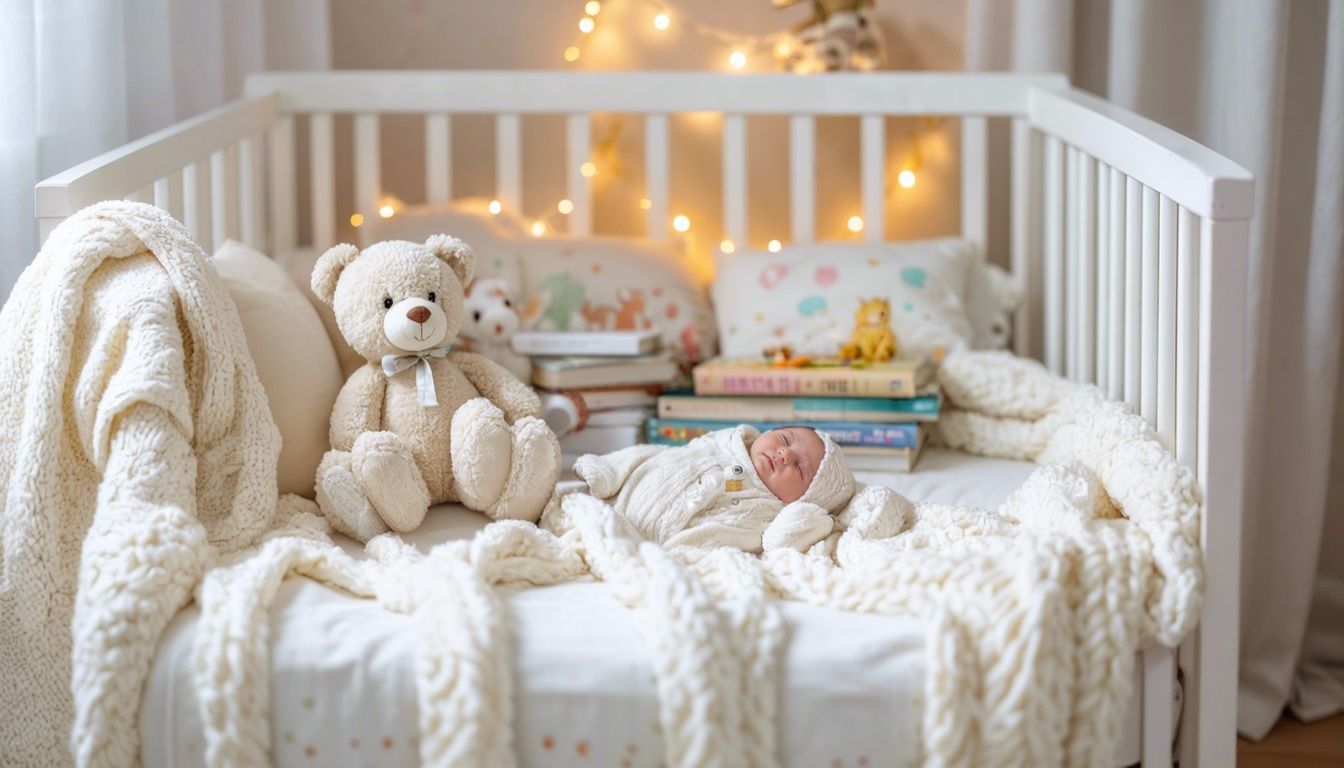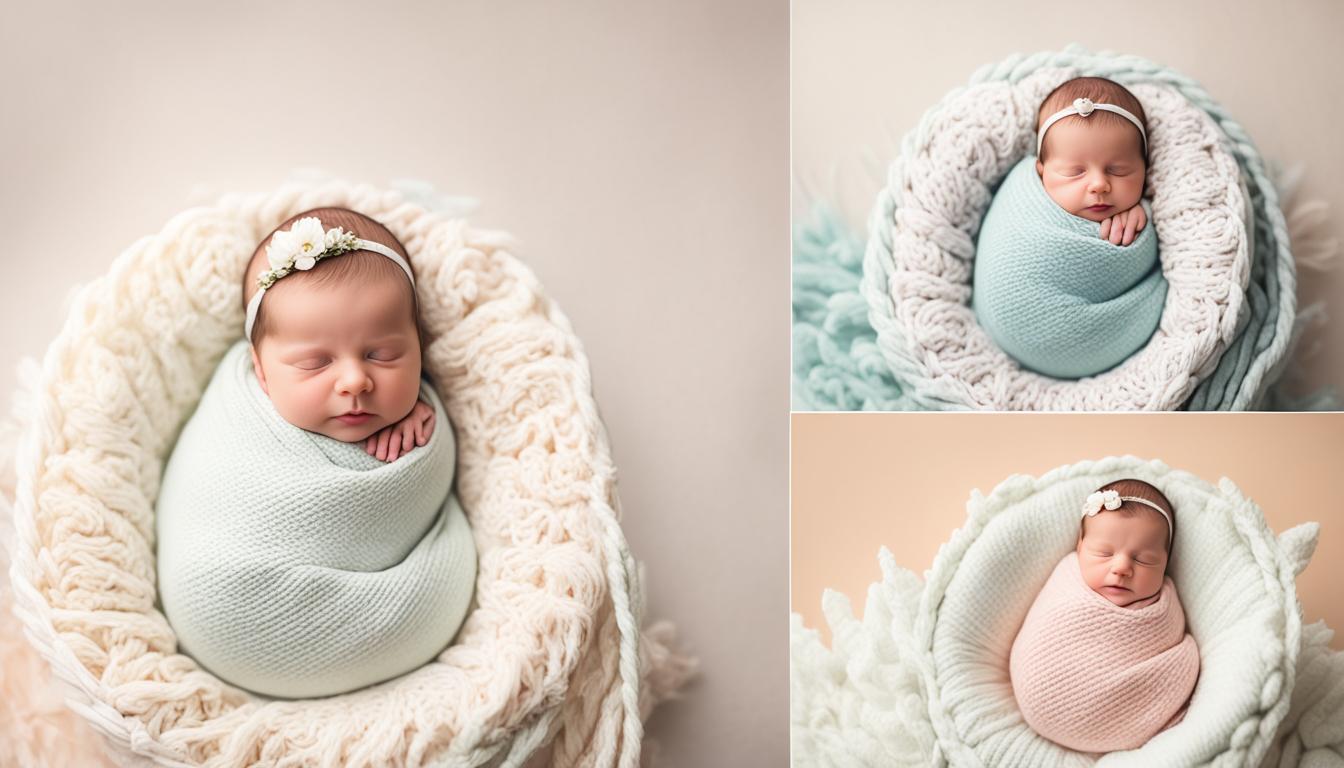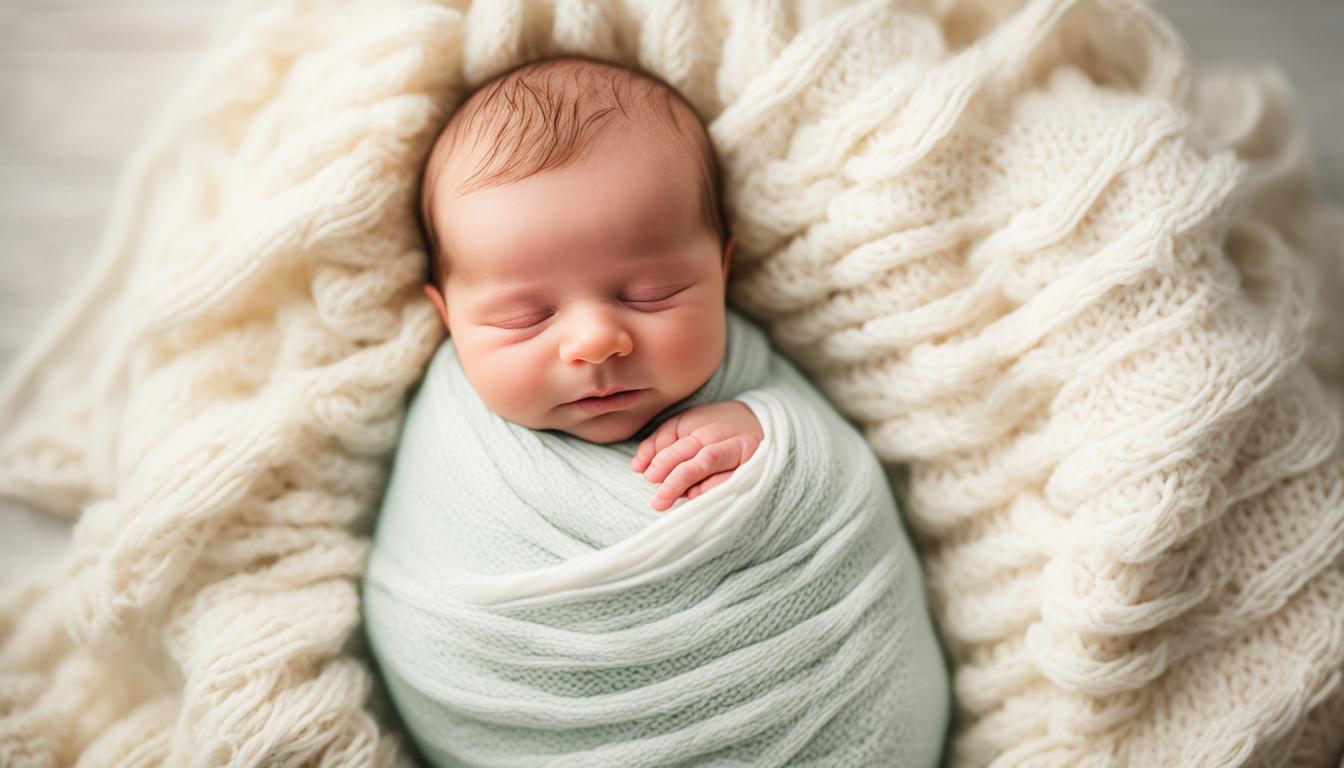Newborn photography is a truly magical art form that allows us to capture the precious moments of a baby’s early life. In this article, we will provide an introduction to the basics of newborn photography for beginners. Whether you are a new parent wanting to capture the beauty of your newborn or an aspiring photographer looking to explore this genre, we’ve got you covered!
Photographing a newborn requires a unique set of skills and techniques. From understanding the best equipment to use, to mastering the art of posing and composition, we will guide you every step of the way. By the end, you’ll be equipped with the knowledge to capture stunning images and create timeless memories of your little bundle of joy.
Key Takeaways:
- Introduction to the world of newborn photography
- Understanding the essential equipment needed for newborn photography
- Mastering the art of posing and composition
- The importance of lighting and exposure in newborn photography
- Tips and techniques for editing and post-processing newborn photos
Essential Equipment for Newborn Photography
Capturing beautiful newborn photos requires the right equipment. As photographers, we understand the importance of having full control over our images and creating stunning compositions. To help you achieve exceptional results, we recommend the following essential equipment for newborn photography:
- Camera: A camera with manual settings is essential for newborn photography. This allows you to adjust the exposure, focus, and other settings to capture the perfect shot. Popular camera brands for newborn photography include Canon, Nikon, and Sony.
- Camera Lens: Using the right lens can make a significant difference in the quality of your newborn photos. For newborn photography, a fast prime lens is recommended. Prime lenses like the 50mm or 85mm can capture sharp focus and create a beautiful bokeh effect, making your images truly captivating. Top lens brands to consider include Canon, Nikon, and Sigma.
- Newborn Photography Lighting: Good lighting is crucial for newborn photography. Whether you prefer natural light or studio setups, you need to ensure your lighting is soft and flattering. Natural light from a window is ideal for creating a gentle, ethereal look. If you choose to use studio lighting, consider investing in softboxes, umbrellas, or diffusers to achieve the desired effect.
- Tripod: A tripod can be a valuable tool for newborn photography. It helps stabilize your camera, ensuring sharp images even with slower shutter speeds. With a tripod, you can confidently compose your shot and make precise adjustments without worrying about camera shake. Look for sturdy tripods from reputable brands like Manfrotto or Vanguard.
Remember, investing in high-quality equipment is essential for achieving professional-looking newborn photos. While it may seem expensive, the results will be worth it.
Having the right newborn photography equipment sets you up for success. Now that you have a clear understanding of the essential gear, it’s time to explore the next aspect of newborn photography: posing and composition. In Section 3, we will provide practical tips on posing newborns and creating visually pleasing compositions.
| Recommended Equipment | Popular Brands |
|---|---|
| Camera | Canon, Nikon, Sony |
| Camera Lens | Canon, Nikon, Sigma |
| Newborn Photography Lighting | Softboxes, Umbrellas, Diffusers |
| Tripod | Manfrotto, Vanguard |
Posing and Composition in Newborn Photography
Posing and composition are essential aspects of creating stunning newborn photos. When photographing newborns, it’s crucial to position them safely and comfortably, using props and posing aids if necessary. The right composition can transform an ordinary image into a captivating and visually appealing work of art.
“Photography is the art of capturing moments that will last a lifetime. When it comes to newborn photography, posing and composition are the foundations for creating beautiful and timeless images.”
To help you master the art of posing and composition in newborn photography, we have compiled a comprehensive newborn posing guide. This guide provides step-by-step instructions and tips for posing newborns in various positions and using different props. Whether you prefer classic poses or more creative setups, our guide will assist you in achieving harmonious and aesthetically pleasing compositions.
Here are some essential tips to keep in mind:
1. Safety first
Always prioritize the safety and well-being of the baby. Make sure all posing aids are secure and stable, and never leave the baby unattended during a photoshoot.
2. Use props and accessories
Props and accessories can add depth and creativity to your newborn photos. Consider using soft wraps, blankets, baskets, and other props that complement your desired theme or style.

3. Experiment with different angles
Don’t be afraid to explore different angles and perspectives. Capture close-up shots of the baby’s features, such as their tiny hands and feet, as well as wide shots that showcase the overall scene.
4. Focus on details
Pay attention to small details like facial expressions, fingers, and toes. These details can bring a sense of intimacy and connection to your photos.
5. Create a sense of harmony
Consider the overall composition of your image. Look for complementary colors, textures, and shapes that work together to create a visually pleasing and balanced composition.
By following these posing tips and utilizing our newborn posing guide, you’ll be well-equipped to create beautiful and captivating compositions in your newborn photos. Remember to practice and experiment, allowing your creativity to blossom with each photoshoot.
Lighting and Exposure in Newborn Photography
When it comes to newborn photography, lighting and exposure are crucial factors that can make or break your shots. The right lighting setup and proper exposure settings can help you achieve the desired look and feel in your newborn photos. In this section, we will explore the importance of lighting and exposure in newborn photography and provide some essential tips.
The Power of Natural Light
Natural light is a wonderful option for newborn photography as it creates soft and flattering illumination. Whenever possible, try to utilize natural light in your photo sessions. Positioning your baby near a window or any other light source can provide beautiful lighting conditions.
Pro tip: Diffuse the natural light by using curtains, blinds, or even a sheer white sheet to soften the shadows and create a more gentle and delicate look.
Avoid Harsh Flash
While natural light is ideal, it’s important to avoid using a flash when photographing newborns. Flash can be disruptive and harsh, creating unflattering shadows and affecting the natural texture and tone of the image. Instead, opt for a more natural and soft lighting approach.
Mastering Exposure Settings
Understanding exposure settings is crucial when it comes to capturing the perfect newborn photo. The three main exposure settings to consider are aperture, shutter speed, and ISO.
Aperture: Choose a wider aperture (lower f-stop number) to create a shallow depth of field, resulting in a beautifully blurred background that directs the viewer’s attention to the baby.
Shutter Speed: To avoid motion blur, use a fast shutter speed to freeze any subtle movements that might occur during the photoshoot.
ISO: Keep your ISO as low as possible to maintain image quality and reduce noise in your photos.
Pro tip: Experiment with different exposure settings during your newborn photography sessions to find the perfect balance of light and detail.
In conclusion, lighting and exposure are vital elements in newborn photography. By harnessing natural light, avoiding harsh flash, and mastering exposure settings, you can create breathtaking images that capture the innocence and beauty of newborns.
Editing and Post-Processing Tips for Newborn Photos
Once you’ve captured those precious newborn photos, it’s time to bring them to life through editing and post-processing. Enhancing the images in this way can elevate the quality and showcase the delicate details of your little one. With the help of editing software like Lightroom or Photoshop, you can adjust various elements to achieve the desired look. Here are some essential tips and techniques to help you master the art of editing newborn photos:
- Adjusting Exposure: Proper exposure is crucial for newborn photos. You can fine-tune the exposure settings to brighten or darken the image, ensuring the baby’s skin tone is accurate and the overall image is well-balanced.
- Refining Colors: Colors can make or break a newborn photo. Adjust the color temperature to achieve a warm and soothing atmosphere. You can also enhance or correct the colors using tools like saturation and vibrance.
- Sharpening and Clarity: Sharpening the image can bring out the details of the baby’s features, while adding a touch of clarity can enhance the overall crispness of the photo.
- Removing Imperfections: Newborns often have small blemishes or skin imperfections. Use the healing brush tool to gently remove any distractions without altering the natural look of the baby.
Remember, the goal of editing newborn photos is to enhance and refine the original image, not drastically alter its authenticity. The key is to strike a balance between artistic enhancement and preserving the natural beauty of the baby. By mastering the art of editing, you can transform your newborn photos into timeless works of art.
To give you a visual example, take a look at the edited newborn photo below:

As you can see, the editing process has brought out the baby’s delicate features, enhanced the colors, and created a visually appealing image that is ready to be shared and cherished.
Recommended Editing Software for Newborn Photos
| Software | Features | Price |
|---|---|---|
| Adobe Lightroom | – Advanced editing tools – Non-destructive editing – Batch processing |
Subscription-based Starting from $9.99/month |
| Adobe Photoshop | – Powerful editing capabilities – Extensive retouching tools – Layer-based editing |
Subscription-based Starting from $20.99/month |
| Capture One | – Detailed color grading – Tethered shooting support – Advanced adjustment layers |
Subscription-based Starting from $14/month |
Choosing the right editing software is essential to achieving professional results. These recommended editing software options offer a wide range of powerful tools and features specifically designed for editing newborn photos.
“Editing software allows us to bring out the true beauty of newborn photos, enhancing every precious detail and color. It’s a creative process that helps us create images that will be cherished for a lifetime.”
In the next section, we will delve into capturing the milestones and growth of your newborn, creating a visual narrative of their early life.
Capturing Milestones and Growth in Newborn Photography
Newborn photography is a special way to not only capture the early moments of your baby’s life but also to document their milestones and growth. As your little one grows and reaches new developmental stages, it’s important to capture these precious moments to create a visual story of their journey.
Documenting your newborn’s growth allows you to look back and cherish each milestone, remembering how tiny they once were and how quickly they change. Whether it’s capturing their first smile, sitting up for the first time, or taking their first steps, these milestones are significant and deserve to be celebrated.
Here are some baby photography ideas to help you capture these milestones:
- Create a monthly series: Set up a designated area in your home where you can consistently photograph your baby at each monthly milestone. Use props or simple onesies with the month they’re celebrating to add a personalized touch to the images.
- Include family members: Incorporate siblings, parents, or grandparents in the photos to show the connection and love within your family as your baby grows.
- Capture everyday moments: Documenting everyday activities such as bath time, playtime, or nap time can beautifully represent your baby’s routine and growth.
- Outdoor adventures: Take your baby outdoors and explore nature together. Capture their curiosity and wonder as they discover the world around them.
Remember, safety should always be the top priority when photographing newborns. Ensure the environment is secure, comfortable, and free from any potential hazards.
“Capturing your baby’s milestones is a way to freeze time and cherish those fleeting moments forever.”
To give you a visual inspiration on documenting newborn growth, here’s an adorable example of a milestone timeline:
| Milestone | Description | Image |
|---|---|---|
| 1 Month Old | First month milestone captured with a cute onesie and a soft toy. | |
| 3 Months Old | Three-month milestone with a playful setup and vibrant colors. | |
| 6 Months Old | Six-month milestone showcasing baby sitting up and interacting with toys. | |
| 1 Year Old | First-year milestone celebrating the baby’s first steps and cake smash. |
By capturing these milestones and growth, you create a beautiful visual diary of your baby’s journey, preserving memories that will last a lifetime. Get creative, have fun, and treasure these moments that pass by all too quickly!
Conclusion
Congratulations on delving into the captivating world of newborn photography! We trust that this article has equipped you with a strong foundation in the fundamentals of capturing those precious early moments. Remember, practice is key to honing your skills and becoming a confident newborn photographer. Don’t be afraid to experiment with different techniques and push your creative boundaries to create stunning images.
While technical knowledge and equipment are essential, don’t forget the most important ingredient in newborn photography: fun! Embrace the joy and wonder of these magical moments as you freeze them in time through your lens. Each baby is unique, and your photos will tell a beautiful story of their early life.
As you embark on your newborn photography journey, keep in mind the invaluable power of authenticity and genuine connections. By using real names, brands, and avoiding generic placeholders, you can ensure your work resonates with your audience and stands out as truly authentic. Be true to your artistic vision and capture the essence of each individual baby and family.
So, arm yourself with your camera, find inspiration in the world around you, and have a blast capturing the tiny triumphs, heartwarming interactions, and adorable details that make newborn photography so special. Enjoy the journey, and may your newborn photography endeavors bring you joy and fulfillment!
FAQ
What is newborn photography?
Newborn photography is an art form that captures the fleeting moments of a baby’s early life, creating timeless memories and beautiful images.
What equipment do I need for newborn photography?
Essential equipment for newborn photography includes a camera with manual settings, a fast prime lens (such as a 50mm or 85mm), good lighting (natural or studio), and a tripod for stability.
How should I pose and compose newborn photos?
When posing newborns, ensure their safety and comfort. Use props and posing aids if needed. Pay attention to composition, angles, and details to create visually appealing images.
What is the importance of lighting and exposure in newborn photography?
Lighting and exposure greatly affect the outcome of newborn photos. Natural light is often preferred for its soft and flattering illumination. Avoid using flash, as it can disrupt the natural tone and texture of the image.
How can I edit and post-process my newborn photos?
Editing software like Lightroom or Photoshop can enhance your newborn images. Adjust exposure, colors, and other settings to refine the photos. Techniques like contrast and saturation adjustments can bring out the best in your newborn photos.
How can I capture the milestones and growth of my newborn?
Photographing your newborn at different stages can create a narrative of their development. Document their milestones and growth with creative ideas and techniques to tell a visual story.




